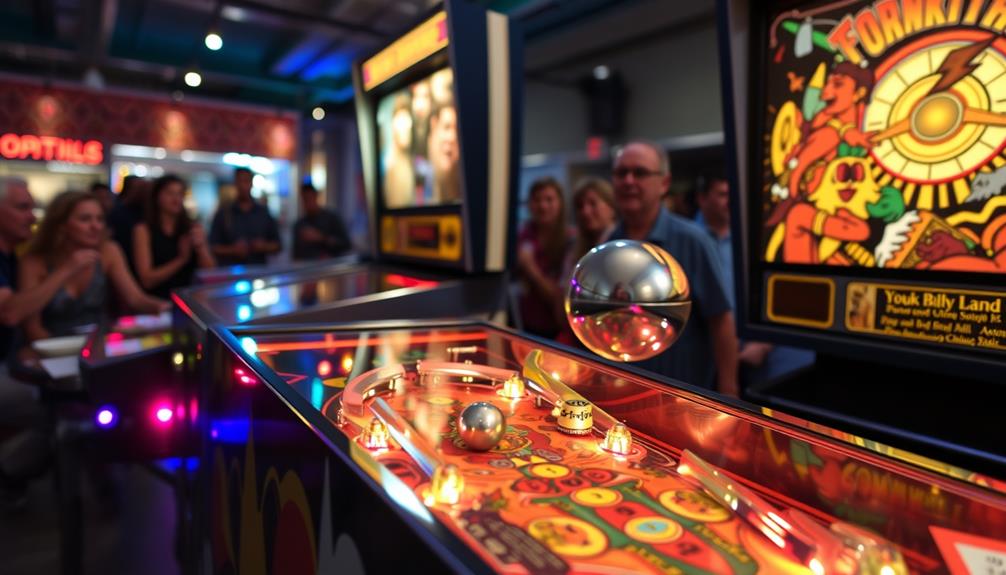To adjust flipper strength safely, start by disconnecting your machine from power to prevent shocks. Use insulated tools and a multimeter to locate and carefully tune the potentiometers near the flipper assembly, making small adjustments while testing response after each turn. Keep track of changes, tighten loose screws, and inspect all connections for integrity. Following these steps helps protect your machine and guarantees consistent performance. Keep exploring for detailed guidance to master the process effectively.
Key Takeaways
- Disconnect power from the pinball machine before starting any adjustment to prevent electrical shock or damage.
- Use insulated tools and wear safety gloves and eye protection during calibration.
- Locate and carefully adjust the potentiometer or coil resistance, making small incremental changes.
- Test flipper response after each adjustment, ensuring smooth movement without excessive force.
- Reassemble and verify all connections are secure; conduct a final safety check before gameplay.
Understanding Flipper Mechanics and Components
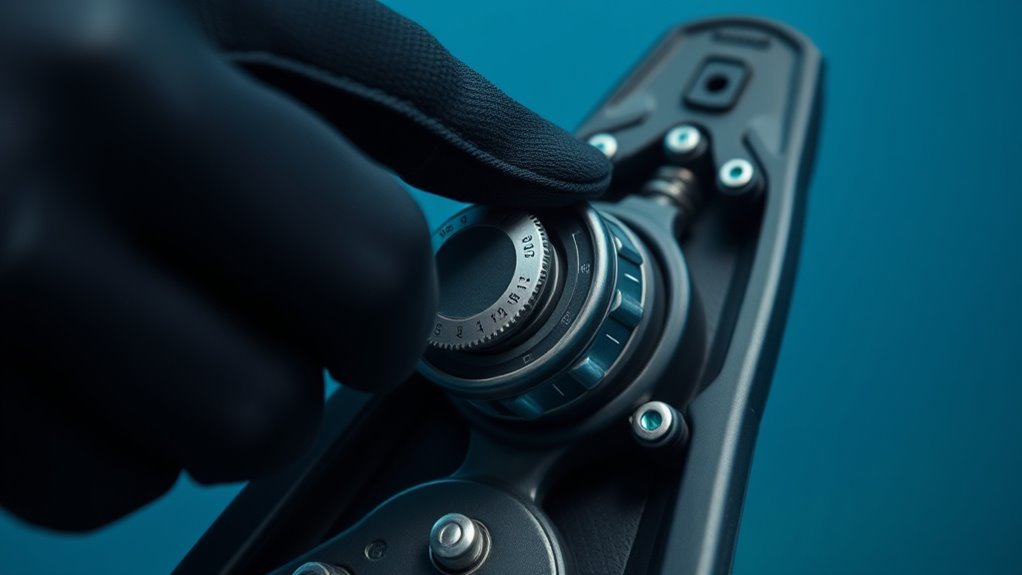
To effectively adjust flipper strength, understanding how flippers work and what components they consist of is crucial. The main component influencing strength is the flipper motor, which powers the movement. Inside the motor, coil resistance plays a critical role; a higher coil resistance can limit current flow, reducing force, while lower resistance allows more current and increases strength. When you examine your flipper assembly, you’ll notice the motor and its wiring, which determine how much power is delivered. Knowing how these elements interact helps you identify potential issues or adjustments needed. By understanding the relationship between the motor’s coil resistance and its performance, you can better decide if adjustments or replacements are necessary to achieve the desired flipper strength. Additionally, understanding electric motor tuning can help optimize performance and longevity of your flipper system.
Gathering the Right Tools and Safety Equipment
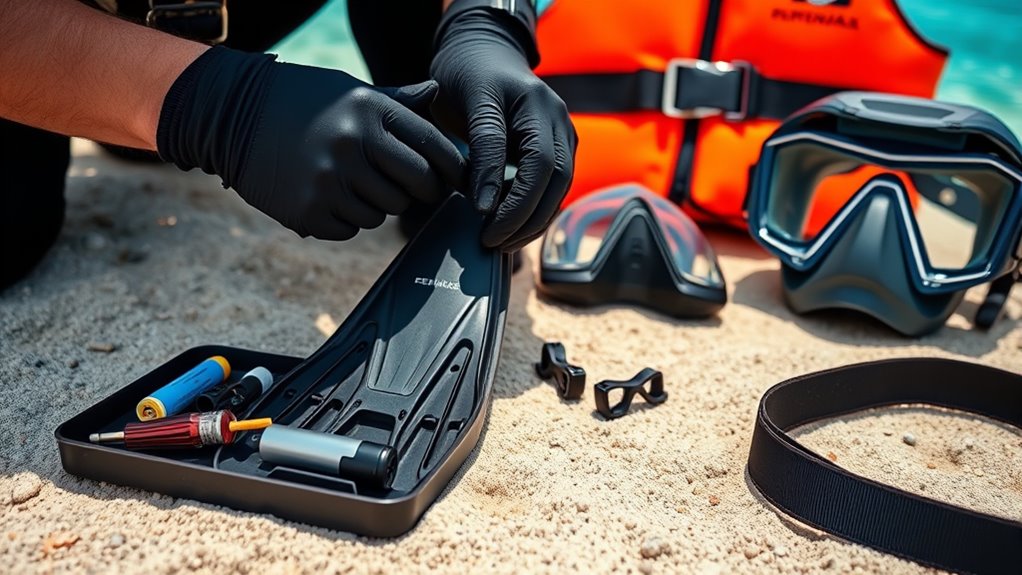
Before you begin adjusting flipper strength, gathering the proper tools and safety equipment is essential to guarantee the process goes smoothly and safely. You’ll need tools to measure and adjust coil safety and power measurement accurately, ensuring you don’t overload the coil or cause damage. Proper safety gear helps protect you from unexpected sparks or electrical issues during adjustments. Additionally, understanding projector calibration techniques can help ensure the flipper adjustments do not interfere with the overall game performance and safety. Consider having these items ready:
Gather essential tools and safety gear to ensure safe, precise flipper strength adjustments.
- Insulated screwdrivers and pliers
- A multimeter for power measurement
- Safety gloves and eye protection
- A heat-resistant mat for workspace safety
These tools help you perform precise adjustments while minimizing risks. Ensuring coil safety and accurate power measurement prevents damage and guarantees safe, effective flipper strength adjustments.
Locating and Adjusting the Flipper Potentiometers
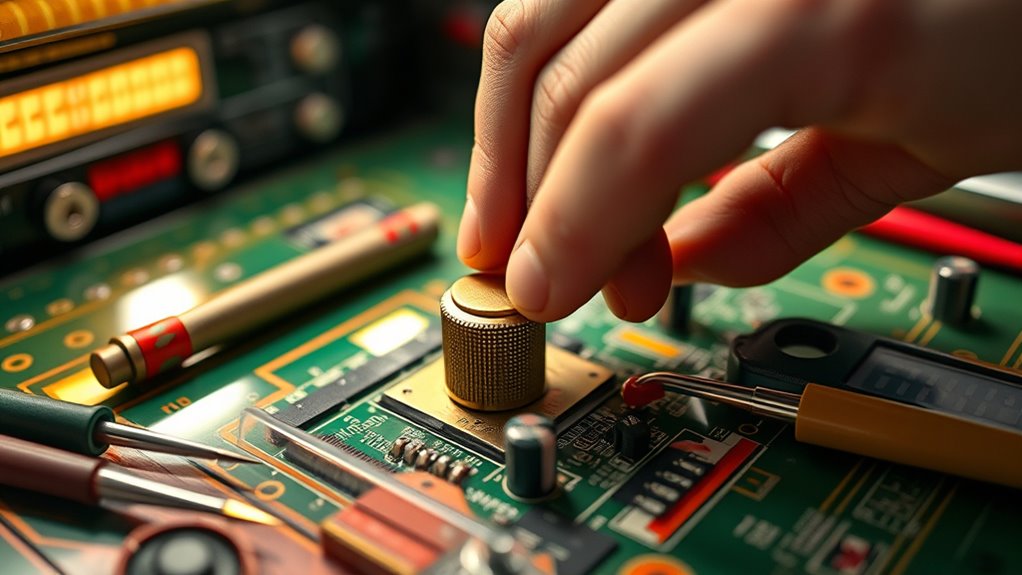
First, locate the flipper potentiometers on your machine, which are typically small, adjustable components near the flipper assembly. Use the correct screwdriver or tool to turn them carefully, ensuring you don’t damage nearby parts. Then, make precise adjustments while testing the flipper’s strength to achieve the desired feel. If you are working on a pinball machine with tuning components, consult the manufacturer’s instructions to prevent any potential damage.
Identifying Flipper Potentiometers
Locating the flipper potentiometers is a straightforward but essential step in fine-tuning your pinball machine’s flippers. These small, adjustable components control the flipper strength and are usually mounted on the driver board. To identify them, look for small, circular components with a screw or slot for a screwdriver. They’re connected to the electrical wiring that supplies power to the flippers. Familiarize yourself with their position to simplify potentiometer calibration later. Confirm the wiring is intact and free of corrosion before making adjustments. Proper identification helps prevent accidental changes to other circuit elements. Remember, accurate locating of these potentiometers ensures safe, effective adjustments to flipper strength without risking damage to your machine’s electrical wiring. Use a flashlight if needed for detailed visibility. Being aware of common issues like corrosion or loose connections can help prevent potential malfunctions during adjustment.
Using Proper Tools
Using the correct tools makes locating and adjusting the flipper potentiometers much easier and safer. You’ll need a Phillips screwdriver or a small flat-head screwdriver to access and turn the potentiometers without damaging components. A digital multimeter can assist in flipper calibration by measuring voltage levels accurately during adjustments. Using proper tools helps prevent accidental slips that could harm the circuit board or worsen flipper issues. When performing flipper repair techniques, precise tool use ensures you don’t strip screws or cause unintended damage. Keep your tools clean and well-maintained for better control. Proper tools streamline the process, reduce frustration, and promote safe, effective adjustments. Investing in quality tools ultimately leads to more accurate flipper calibration and reliable gameplay. Additionally, understanding AI vulnerabilities can help in developing safer calibration techniques that prevent digital or hardware malfunctions during maintenance.
Making Precise Adjustments
To make precise adjustments to your flipper, start by carefully identifying the potentiometers on the circuit board, which are usually small, variable resistors labeled “L” or “R” for left and right flippers. These control the flipper calibration and power regulation, ensuring smooth operation. Use a small screwdriver to turn the potentiometers slowly, testing each adjustment before proceeding. Keep these tips in mind:
- Turn clockwise to increase power or flipper strength.
- Turn counterclockwise to decrease strength for safer operation.
- Make small adjustments and test frequently.
- Avoid over-tightening, which can damage the potentiometer.
Additionally, consult AI technology to understand how data analytics can help monitor and optimize your flipper’s performance over time.
Testing Flipper Strength and Making Fine-Tuned Adjustments
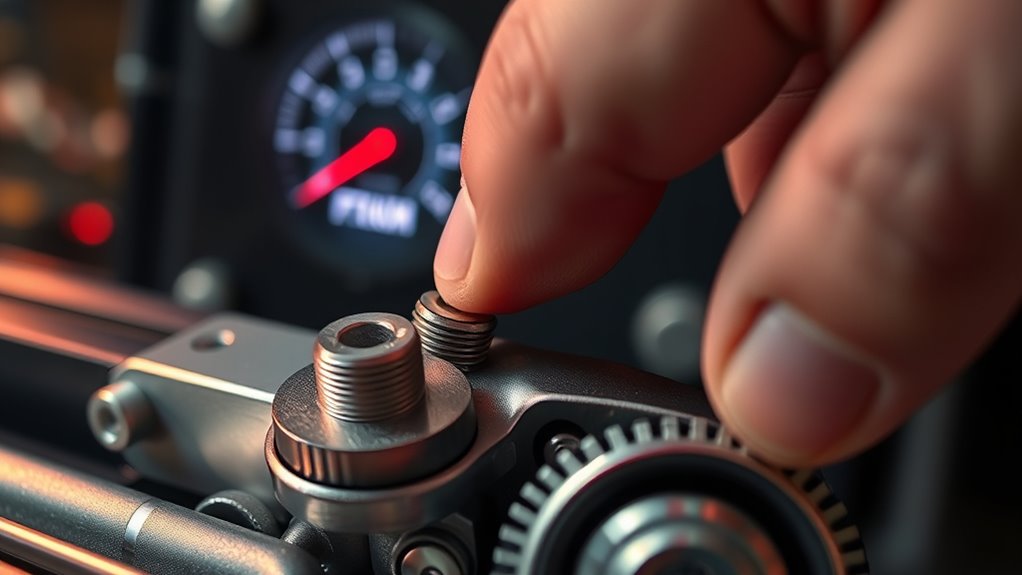
To guarantee your flippers are working at their best, you need to measure their power accurately. Use a consistent testing method to gauge how well they respond and make precise adjustments. Fine-tuning techniques help you achieve the perfect balance between strength and control. Incorporating performance enhancement practices can further optimize your results and ensure safety during use.
Measuring Flipper Power Accurately
Accurately measuring flipper power is essential for ensuring your pinball machine plays just right. To do this, focus on evaluating flipper speed and the impact of flipper material. Proper measurement helps you determine if your flippers are too weak or too strong, allowing for precise adjustments. Use a stopwatch or a digital sensor to gauge flipper speed during activation. Keep in mind that flipper material, like rubber or nylon, affects how force is transmitted and how the flipper responds. To get an accurate picture, consider these steps:
- Record flipper speed with a timer or sensor
- Observe the ball’s response and trajectory
- Check for consistency across multiple tests
- Adjust power based on the flipper material’s influence on performance
- Use expert voice actors to better understand how to communicate your adjustments clearly and effectively.
Fine-Tuning Adjustment Techniques
Once you’ve measured your flipper’s basic strength, fine-tuning involves testing its response under real gameplay conditions and making small adjustments to achieve ideal performance. You’ll want to observe how the flipper reacts during play, ensuring it hits targets accurately without excessive force. Adjustments can be made by tweaking the coil settings or repositioning the linkage, employing proper flipper replacement techniques if needed. Keep in mind, flipper aesthetics also matter—clean, well-maintained flippers look better and can influence your confidence during play. Fine-tuning isn’t just about strength; it’s about creating a smooth, responsive experience. Make incremental changes, test thoroughly, and avoid over-tightening or loosening components, which could damage the mechanism or affect the flipper’s visual appeal. To maintain optimal performance, consider regular maintenance to prevent wear and ensure consistent response.
Safeguarding Your Machine During Adjustment Procedures
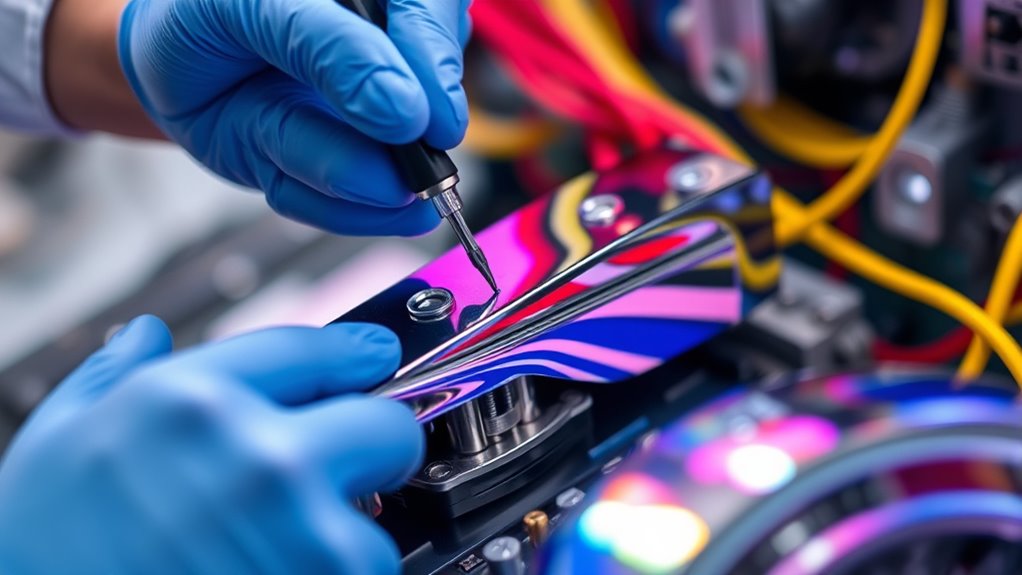
Before you begin adjusting the flipper strength, it’s essential to take measures that protect both your machine and yourself. Proper safeguards ensure accurate machine calibration and preserve the delicate balance of flipper physics. First, disconnect the machine from power to prevent accidental activation. Next, wear safety gloves to avoid injuries from sharp components. Use a soft cloth or cover to shield sensitive parts from dust and debris. Lastly, consult your machine’s manual for specific calibration points to prevent over- or under-adjustment, which can disrupt flipper physics. These steps help you maintain the integrity of your machine, minimize risks, and ensure safe, effective adjustments. Taking these precautions creates a safe environment for fine-tuning your flipper strength without compromising performance or safety. Additionally, understanding auditory processing techniques can enhance your approach to calibration by improving your focus and precision during adjustments.
Final Checks and Maintaining Flipper Performance

After completing your flipper adjustments, it’s crucial to perform final checks to make sure everything functions correctly. Begin by testing the flipper’s movement to confirm proper calibration, ensuring it responds smoothly without sticking or excessive force. Check all electrical connections for security, and verify that wires aren’t loose or frayed. Conduct safety precautions by unplugging the machine before making any further adjustments or inspections. Examine the flipper assembly for signs of wear or damage, and tighten any loose screws or bolts. Regularly maintaining your flipper’s calibration helps preserve performance and prevents potential malfunctions. Keep records of your adjustments so you can track changes over time. Consistent final checks ensure your flippers perform reliably and safely, enhancing your overall gaming experience.
Frequently Asked Questions
Can Adjusting Flipper Strength Void the Pinball Machine’S Warranty?
When you adjust flipper strength, you might worry about warranty implications. Generally, manufacturers’ guidelines specify that any modifications should be done carefully to avoid voiding your warranty. If you alter the flipper strength improperly, it could be considered unauthorized repair or modification, which might void coverage. Always check your machine’s warranty terms and follow manufacturer guidelines to guarantee your adjustments don’t affect your warranty status.
What Signs Indicate Flipper Strength Is Too Weak or Too Strong?
You’ll notice if your flipper strength is too weak when the flippers respond slowly or fail to flip the ball effectively, making control difficult. Conversely, if the flippers are too strong, they may cause erratic responses or overpower the ball, reducing precise ball control. Pay attention to flipper responsiveness during play; smooth, controlled flips indicate proper strength, while inconsistent actions suggest it’s time to adjust.
Are There Recommended Safety Practices for Children During Adjustments?
You might notice that children often mimic adults, highlighting the importance of proper supervision. When adjusting flipper strength, always supervise your child closely and make sure they wear protective gear. Keep devices away from distractions, and teach them to stay still during adjustments. These practices help prevent accidents and ensure safety. Remember, consistent child supervision and the right protective gear are essential for safe adjustments, fostering confidence and safety in young users.
How Often Should Flipper Strength Be Recalibrated?
You should regularly check your flipper calibration to guarantee ideal performance. How often you recalibrate depends on the device’s usage and manufacturer recommendations, but generally, following a maintenance schedule every few months is ideal. Keep an eye out for any signs of inconsistency or malfunction, and perform recalibrations promptly. This proactive approach helps maintain the device’s accuracy and safety, ensuring it continues to function effectively over time.
Can I Use Household Tools for Flipper Adjustments Safely?
Sure, you can try DIY adjustments with household tools—because who doesn’t love the thrill of mixing tool safety with a dash of chaos? Just remember, using the wrong tools risks damaging your flipper or hurting yourself. It’s tempting, but for precise, safe results, stick to proper calibration methods. After all, a little caution beats a costly mistake, so prioritize tool safety over quick fixes.
Conclusion
As you finish adjusting your flipper, remember that precision and patience blend seamlessly—like the perfect game. Sometimes, small tweaks can unexpectedly improve your entire experience, revealing how even minor efforts shape bigger victories. By safeguarding your machine and staying attentive, you not only enhance performance but also discover that success often hinges on careful attention to detail. Ultimately, your dedication transforms routine adjustments into moments of mastery, reminding you that progress often begins with a simple, mindful step.


